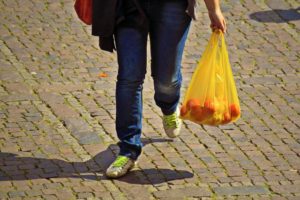At a Glance
- Plastic bans target specific single-use items, not all packaging — common hits include bags, foam containers, straws, utensils, and small water bottles.
- Rules vary widely, with a mix of city and state regulations, plus some states blocking local bans.
- Business impact includes packaging changes, cost shifts, and tracking compliance across regions.
- Trends to watch: lead times for implementation, corporate sustainability moves, and growth in recycled or compostable alternatives.
Before you start reading this article, there is something important that you need to know: the writer is by no means a legal expert and is not trying to explain what laws are being enforced by which states, why, when, and how. If you’re looking for definitive legal advice about plastic bans, this article has about as much authority as a fortune cookie — entertaining, possibly insightful, but not something you’d want to stake your business on in court.
This information aims to provide food industry professionals with a high-level overview of how current plastic bans are implemented and how they might impact their business operations. Think of it as your plastic prohibition map — just detailed enough to keep you from accidentally wandering into a “no single-use straws allowed” territory while carrying a bundle of them (as one does).
At Inline Plastics, we have seen regulations evolve over the past 55 years of business and would like to share some of our insights with you.
Treat this guide as a launchpad for your research. It will help you explore the regulations that affect your location and business model.
The Patchwork Reality of Plastic Bans
 When it comes to plastic bans in the United States, there’s no simple, one-size-fits-all explanation. We’re seeing a mix of rules that greatly change from state to state. Sometimes, they even differ from city to city within the same state.
When it comes to plastic bans in the United States, there’s no simple, one-size-fits-all explanation. We’re seeing a mix of rules that greatly change from state to state. Sometimes, they even differ from city to city within the same state.
This creates a challenging landscape for food industry professionals to navigate. A catering business may follow all the rules in one city. But they could face fines in a neighboring area if they operate just a few miles away. So, who’s actually the one kicking some plastics to the curb? Let’s take a deeper look.
State vs. City: Who’s Calling the Shots?
The implementation of plastic bans follows various patterns across the country:
- State-wide bans: Some states have implemented uniform regulations that apply across all municipalities. This is clearly the most straightforward approach. It gets more complicated moving forward.
- City-specific regulations: Some cities choose to ban plastics independently, even if the state does not. For example, Atlanta, Georgia, prohibits city contractors from using single-use plastic bags, straws, and polystyrene containers despite Georgia having no state-wide ban.
- State preemption laws: Interestingly, some states (including Florida, Arizona, South Carolina, and Missouri) have attempted to pass legislation specifically preventing cities and counties from implementing their own plastic bans. This creates a sort of “anti-ban” that preserves the status quo.
What’s Actually Being Banned?
Despite the scary headlines about “plastic bans,” these regulations rarely target all plastic products. Instead, they focus on specific items:
- Plastic bags: The most common targets are thin, single-use plastic bags from grocery stores. Some regulations specify thickness requirements, with the idea that thicker bags might be reused.
- Expanded polystyrene (EPS), commonly called Styrofoam, faces strict limits. It breaks down into microplastics faster than other plastics, causing serious environmental issues.
- Plastic straws and utensils: We all love sea turtles and would never want to see them harmed, but straws and utensils aren’t outright banned in all cases. Many places are now using “by request only” policies for these items. This means businesses cannot automatically add them to takeout orders.
- Small water bottles: Some places do not allow the sale of small plastic water bottles. Instead, you have to buy bigger bottles or use other packaging.

It’s important to note that current bans mostly do not affect plastic food containers, such as those for salads and prepared meals. It does, however, include food containers with “problematic or unnecessary materials” such as black bottoms, as described by the US Plastic Pact 2023-24 report. The focus remains on bags, foam containers, and plastic accessories like straws and utensils.
The Business Impact of Plastic Bans
For food industry professionals, these regulations create several practical challenges:
Compliance Complexity
Businesses operating across multiple jurisdictions face the challenge of tracking different regulations. For example, a restaurant chain with locations in different cities may need unique packaging for each one.
Cost Considerations
 Alternative materials often come at a premium. Paper bags typically cost more than plastic ones, which explains why many stores now charge for bags in areas with plastic bag bans. These costs may need to be absorbed by businesses or passed on to consumers. Paper bags have their own environmental issues. They produce high carbon emissions during production. However, they are not banned in the U.S.
Alternative materials often come at a premium. Paper bags typically cost more than plastic ones, which explains why many stores now charge for bags in areas with plastic bag bans. These costs may need to be absorbed by businesses or passed on to consumers. Paper bags have their own environmental issues. They produce high carbon emissions during production. However, they are not banned in the U.S.
Consumer Behavior
The effectiveness of these bans sometimes comes into question. Mandated reusable bags could end up discarded rather than reused, creating a different type of waste problem. Understanding how consumers actually use alternatives is crucial for predicting long-term impacts.
Where to Find Information About Specific Plastic Bans
The fragmented nature of these laws makes it challenging to stay informed. However, several resources can help:
- Industry associations like the Foodservice Packaging Institute (FPI) offer regulatory information to members.
- Environmental websites such as the National Wildlife Federation maintain maps of plastic bans.
- Local government websites typically provide information about regulations specific to their jurisdiction.
Looking Ahead
The landscape of plastic regulation continues to evolve. A few trends worth watching:
Implementation Timelines
Most plastic bans allow for a significant lead time. This is usually 3-5 years from the time the law passes to the time it starts, giving businesses time to adjust.
Corporate Adoption
Many large companies are proactively adopting sustainable alternatives even in areas without bans. Hotel chains are installing wall-mounted soap dispensers across the country. This shows how companies often prefer standardizing their practices instead of changing them for each location.
Innovation in Materials
The plastic industry isn’t standing still and big changes are happening. Recycled content is increasing, recyclability is improving, and new biodegradable or compostable options are being created. These advances may influence future regulation and provide more options for businesses.
Conclusion: It’s Not a Total Ban-anza
 Food industry professionals must keep up with regulations in their specific areas. Plastic bans can cause short-term challenges, but they also spark innovation and offer businesses opportunities to lead in environmental efforts.
Food industry professionals must keep up with regulations in their specific areas. Plastic bans can cause short-term challenges, but they also spark innovation and offer businesses opportunities to lead in environmental efforts.
Remember that most bans target specific items like bags, foam containers, and utensils — not all plastic packaging. To comply and adapt successfully, first understand what’s regulated in your area. This will help you avoid potential headaches.
Being flexible and aware as regulations change will help navigate this complex landscape. The Wild West of plastic legislation isn’t going away anytime soon, but with the right information and planning, food industry businesses can successfully adapt to changing expectations and requirements — just think of yourself as the savvy (or sassy) new sheriff in town, armed with compliance knowledge and ready to face a new day.
Are you interested in learning more about the plastics industry? Visit the Inline Plastics Learning Center today. If you have any questions, feel free to reach out. We’re here to help!

